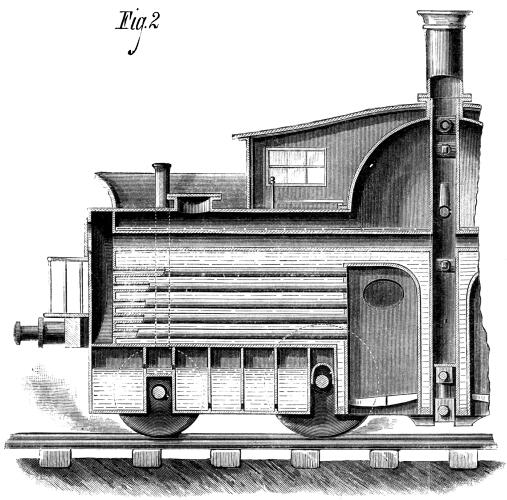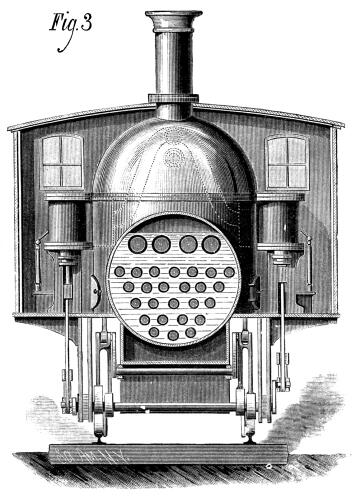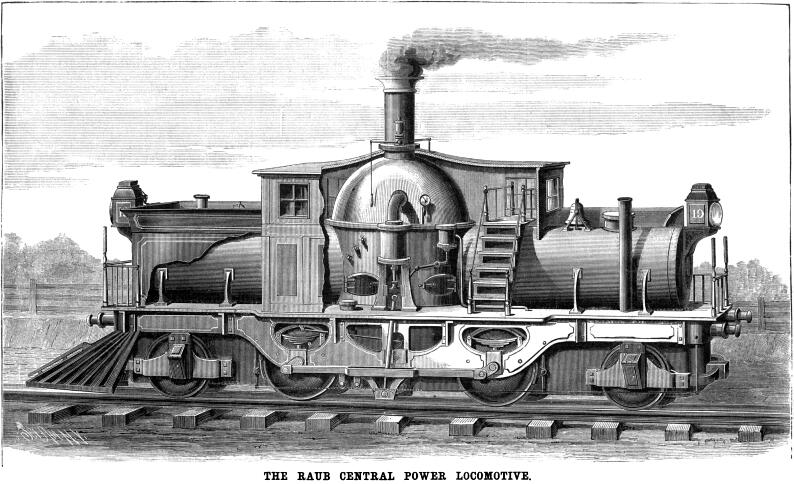THE RAUB CENTRAL POWER
LOCOMOTIVE.
Scientific American—October 15,
1881
We present illustrations of a new system of constructing railroad
locomotives, recently patented by the inventor, Doctor Christian
Raub, of New York city. The object of this invention is to construct
a perfectly balanced locomotive, in which the center of gravity
is coincident with the vertical median line of the engine, and
in which the motive power is located at the middle of the engine
in a plane extending through h the center of gravity. These two
objects being attained, it is hardly possible to  overestimate the value of the invention,
since the locomotive will then be constructed upon correct principles
and according to natural laws. It works from its center, and has
its motive power situated in a plane extending through its center
of gravity, and has therefore no dead weight. overestimate the value of the invention,
since the locomotive will then be constructed upon correct principles
and according to natural laws. It works from its center, and has
its motive power situated in a plane extending through its center
of gravity, and has therefore no dead weight.
It is not within the scope of this article to review the various
attempts and experiments undertaken in the course of time in this
direction, but it may be stated generally that the problem of
locating the center of gravity in a railroad locomotive upon the
center of its base formed by the driving wheels, and to place
the motive power at that center, had not been solved before the
invention of Dr. Raub; and probably the reason why these attempts
have not been successful is, that the fact was not sufficiently
realized that Stephenson's system was at variance with the principles
above referred to, and that nothing short of a radical change
of the whole system of construction could lead to success; any
improvement upon the original design, no matter how great, could
not overcome the faults or disadvantages which were inherent in
the system as a whole.
Dr. Raub, in order to definitely locate the center of gravity,
has constructed his engine in such a manner that each half of
the total structure, whether divided longitudinally or laterally,
is an exact counterpart or duplicate of the other half, both as
regards weight or measure; the consequence of this is that the
center of gravity is in the intersection of the longitudinal and
transverse center planes of the entire locomotive; and by placing
his motive power in the central transverse vertical plane of the
engine he has disposed the parts of his locomotive to the best
advantage for economy and efficiency.
The engravings represent the invention so clearly as to require
but little explanation. The whole engine rests upon an oblong
platform which extends all around the structure, and which is
made wider in the middle to support the engineer's cab, which
will be as wide as the cabs now in use; at each side of the engine
is a boiler extending longitudinally to the end of the locomotive,
each boiler having a separate firebox, which is located in the
cab. The boilers have ordinary flues, which terminate in a smoke
chamber at the extreme ends of the locomotive, but instead of
allowing the heat and gases to escape through smokestacks at the
ends, as in the present locomotives, they are conducted through
return flues of a larger size (as shown in Fig. 3) to an interior
collecting smoke chamber, which thus collects the smoke and gases
from both boilers, and allows them to escape through one common
smokestack which stands above it. This collecting smoke chamber
extends upward and downward vertically through the entire locomotive,
and serves not only as a brace to the steam dome which surrounds
its upper portion, but also gives an additional support and strength
to the entire structure. The steam dome stands in the center of
the locomotive, its axis being the exact center of the engine.
It is stiffened by the collecting smoke-chamber which extends
through it. A separate valved connection is made through this
interior smoke-chamber for the steam as well as for the water
in the boilers, so that both steam and water can circulate freely
from one boiler to the other, or may be shut off if it is desired
to use one boiler  only.
The steam cylinders are vertical, and placed outside the steam
dome, their axes being in the vertical transverse plane extending
through the center of gravity of the locomotive, and preferably
placed as high as possible, so as to take the steam by means of
pipes which receive their steam supply from a common opening at
the highest point in the steam dome, the opening being closed
by a throttle-valve operated in the usual manner. The steam chests
are placed inside the dome as shown in Fig. 3. only.
The steam cylinders are vertical, and placed outside the steam
dome, their axes being in the vertical transverse plane extending
through the center of gravity of the locomotive, and preferably
placed as high as possible, so as to take the steam by means of
pipes which receive their steam supply from a common opening at
the highest point in the steam dome, the opening being closed
by a throttle-valve operated in the usual manner. The steam chests
are placed inside the dome as shown in Fig. 3.
The driving-wheels are situated equidistant from the center
line, and upon them rests the whole platform, and in the center-line,
and. as near the rails as possible, is placed an intermediate
driving shaft, to the cranks of which, on opposite sides of the
locomotive, extend the connecting rods from the cross-heads of
the piston rods above. The cranks of the two drivers on each side
of this vertical connecting rod are connected in the usual manner
by a horizontal driving rod, which, near its center, extends downward
to the crank of the intermediate driving shaft and is connected
with it. The driving rod is slotted in its center to allow the
vertical connecting rod free play.
The eccentrics are placed upon the intermediate driving shaft,
while the link motions are arranged on an auxiliary shaft vertically
above it.
The locomotive may have horizontal cylinders, if they should
be preferred. In that case they would be placed lower down in
a line with the center of the driving wheels, but in the same
central position.
At each end of the locomotive the frame rests upon a truck,
but as the whole engine is evenly balanced upon and supported
by the driving wheels, the object of the trucks is not so much
to support any specific weight, as in other locomotives, as to
serve as a guide over curves. Each end truck has one transverse
axle with one pair of wheels and a frame which incloses the wheels
and is connected by an arc-shaped guide piece, which is transversely
guided in a fixed center box at the end of the locomotive.
The water tanks are below the boilers, openings being provided
to allow the axles of the wheels to pass through. The fuel is
carried in bunks arranged, sideways and above the boilers.
A novel and ingenious plan is devised for feeding the boilers.
The return flues being situated but a few inches below the water
level, it is important that the level should be continually kept
up. The inventor has, therefore, arranged a steam pump, which
is worked by a lever connection with the main piston, and which
injects into the boilers at each stroke of the piston the equivalent
of water for the steam used.
These are the main features of this novel engine, which the
inventor claims as the first locomotive built upon strictly scientific
principles.
The advantages claimed for this new style of locomotive, and
to which Dr. Raub has given the appropriate name of central power
locomotives, are numerous.
This engine has no dead weight, therefore its whole power can
be utilized for drawing freight; and it is claimed that a central
power locomotive of any given size will do more work than another
locomotive of the same size under the same conditions. The heat
is better utilized, as it is led back through the boiler by means
of the return flues, and the fuel will be more fully consumed
than it is now. The collecting smoke chamber, which extends upward
through the steam dome, serves to superheat the steam, consequently
dry steam will be obtained, and the steam chests being inside
the dome, no loss of steam from condensation will take place.
Should an accident happen to one of the boilers, the connection
between the two may be interrupted, and the remaining boiler will
be sufficient to propel the train to the next station, thus preventing
blocks on the road and delays to traffic.

It is claimed that a train may be run at a much higher rate
of speed with this engine and with much more safety than now,
owing to the balanced driving wheels and the peculiar relation
of the parts; and there is less danger of breaking the driving
rods and less strain upon the track.
A separate tender will not be required, as both water and fuel
are carried upon the locomotive itself; and, furthermore, turn-tables
with their necessary attendance will become superfluous, since
the locomotive is a perfect double-ender, and runs in either direction
with equal efficacy and without any damaging effect to the gearing.
We understand that Dr. Raub is now making arrangements to build
several locomotives according to his new system of different patterns
and sizes, in order to practically test their merits and superiority
and to ascertain the actual percentage of saving in running them.
The doctor has for many years been identified with several
large Western roads, and is well known as a prominent and able
railroad engineer.
Stories Page | Contents Page
|







